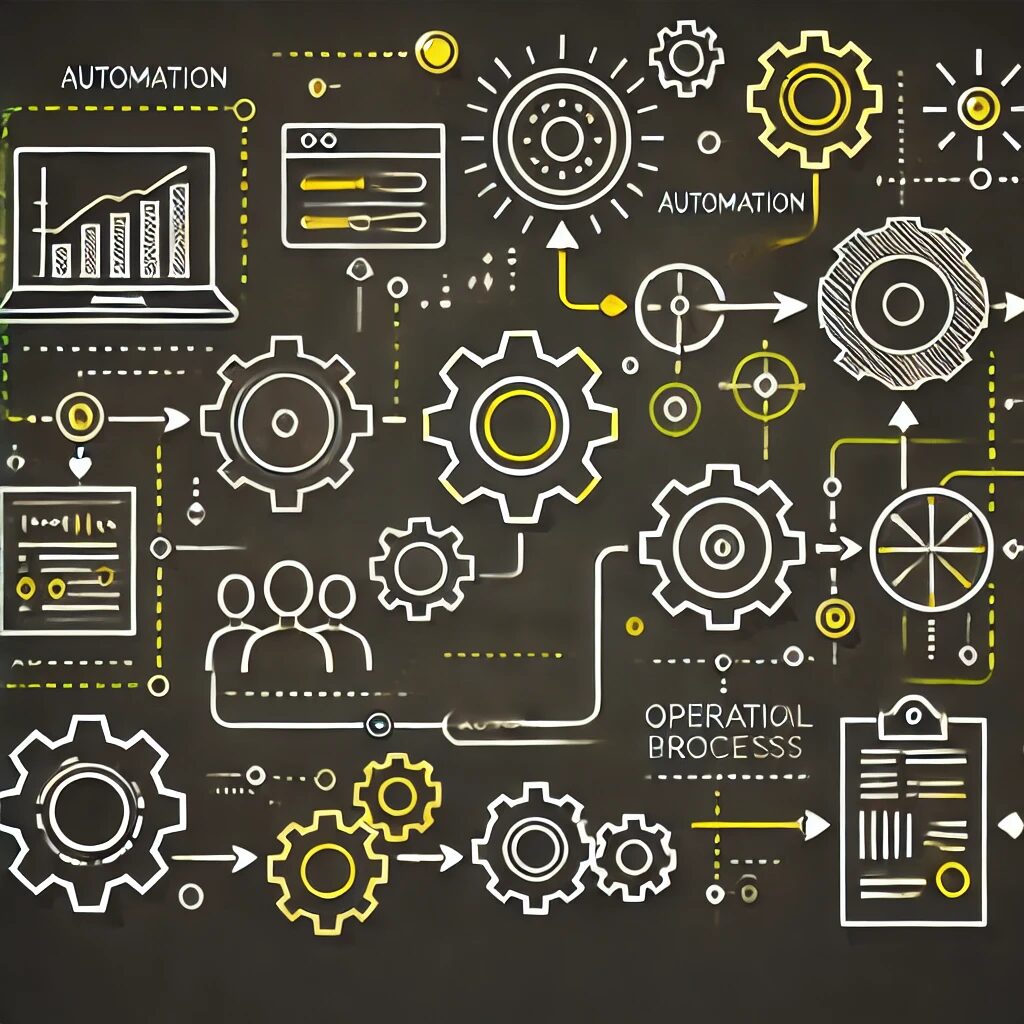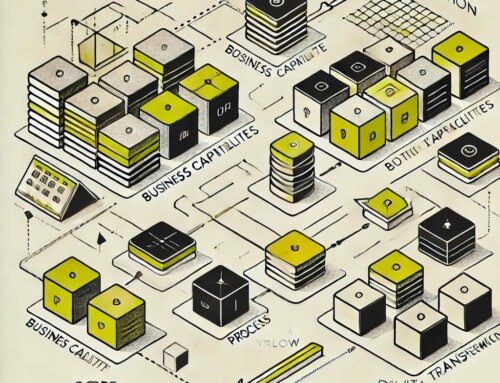
Capability Mapping as a Strategic Compass for Utility Transformation. Navigate the Grid of Tomorrow with Business-Driven Clarity.
In today’s rapidly evolving utilities landscape, the traditional approach of managing technology and operations in silos is no longer sustainable. As regulatory pressures mount, customer expectations evolve, and the transition to sustainable energy accelerates, utilities must fundamentally rethink how they align their operational capabilities with strategic objectives. Business capability mapping provides the critical framework to bridge this gap.
A business capability map offers a comprehensive view of what your utility does—independent of how you do it—creating a stable reference model that transcends organizational structures, technologies, and short-term initiatives. By establishing this enterprise-wide perspective, utilities can optimize operations and technology investments based on business value, not departmental priorities or technical constraints.
1: The Capability Mapping Imperative for Utilities
The utilities sector faces unprecedented disruption that demands new operational and technology strategy approaches. Business capability mapping provides the foundation for navigating this complexity with confidence.
- Industry Transformation: Traditional utility business models are challenged by renewable energy integration, distributed resources, and changing regulatory frameworks requiring clearer operational priorities.
- Siloed Operations: Most utilities struggle with operational silos that create inefficiencies, duplicate capabilities, and hamper the agility needed to respond to market changes.
- Technology Complexity: The typical utility manages hundreds of applications across dozens of technology platforms, creating significant cost and complexity without clear business alignment.
- Investment Prioritization: Utilities face difficult choices in allocating limited capital and operational budgets across competing priorities from grid modernization to customer experience enhancements.
- Regulatory Scrutiny: Increasing regulatory pressure demands utilities demonstrate prudent investment decisions with clear business justification and measurable outcomes.
2: Business Capability Maps: The Foundation for Strategic Alignment
A business capability map creates the essential bridge between strategic intent and operational execution, providing a consistent framework for decision-making across the enterprise.
- Strategic Translation: Capability maps transform abstract strategic objectives into concrete operational capabilities that must be developed, maintained, or enhanced.
- Business-Technology Alignment: Capability mapping creates a shared language between business and technology leaders, ensuring investments deliver meaningful operational outcomes.
- Investment Prioritization: By assessing capability performance against strategic importance, utilities can direct resources to areas of highest business impact.
- Enterprise Perspective: Capability maps transcend organizational boundaries, revealing opportunities for consolidation, standardization, and resource optimization.
- Transformation Roadmap: A well-developed capability map provides the foundation for creating logical, sequenced transformation initiatives with clear business justification.
3: Core Elements of a Utility Business Capability Map
Effective utility capability maps share common structural elements that balance strategic perspective with operational detail.
- Capability Hierarchy: A tiered structure with Level 1 capabilities (e.g., Asset Management) decomposing into more granular Level 2 and 3 capabilities (e.g., Asset Inspection, Maintenance Planning).
- Domain Organization: Logical grouping of capabilities into domains such as Grid Operations, Customer Experience, Energy Supply, and Enterprise Management.
- Capability Attributes: Metadata associated with each capability, including strategic importance, current performance, risk exposure, and technology enablement.
- Relationship Mapping: Documented connections between capabilities showing dependencies, information flows, and service relationships.
- Performance Indicators: Defined measures for assessing capability effectiveness, efficiency, and contribution to strategic objectives.
Did You Know:
- According to a 2023 study by the American Gas Association, utilities with mature business capability mapping practices allocate on average 27% more of their technology budget to strategic initiatives versus routine maintenance compared to utilities without capability frameworks.
4: Utility-Specific Capability Domains
While industry reference models vary, most utility capability maps include these essential domains that reflect the sector’s unique operational characteristics.
- Grid Operations: Capabilities for managing physical infrastructure, from long-term asset planning to real-time network operations and outage management.
- Customer Experience: Customer-facing capabilities from acquisition and enrollment to billing, service delivery, and support across traditional and digital channels.
- Energy Supply: Capabilities for generation management, energy procurement, trading, and portfolio optimization to ensure reliable, cost-effective supply.
- Regulatory Management: Capabilities for navigating complex regulatory environments, including compliance, rate cases, and stakeholder engagement.
- Product & Service Management: Capabilities for developing and managing both traditional utility offerings and emerging services like distributed energy solutions or electric vehicle programs.
5: Operational Optimization Through Capability Assessment
Capability assessment transforms static maps into dynamic tools for operational improvement by identifying performance gaps and optimization opportunities.
- Performance Benchmarking: Systematic assessment of current capability performance against industry benchmarks reveals operational improvement opportunities.
- Capability Rationalization: Mapping reveals duplicate capabilities across organizational silos, enabling consolidation and standardization of operations.
- Process Alignment: Capability assessment identifies disjointed processes that cross organizational boundaries, creating opportunities for end-to-end optimization.
- Resource Optimization: Clear capability ownership models eliminate overlapping responsibilities and resource conflicts across operational teams.
- Skill Gap Identification: Capability assessments reveal workforce skill gaps that must be addressed to achieve desired operational performance.
6: Technology Portfolio Optimization
Mapping applications and technologies to business capabilities creates powerful insights for rationalizing complex IT landscapes.
- Application Rationalization: Capability-to-application mapping reveals redundant systems, creating opportunities to consolidate applications and reduce technology costs.
- Investment Alignment: Technology investments can be prioritized based on the strategic importance of the capabilities they enable, rather than departmental influence.
- Legacy Modernization: Capability mapping identifies high-priority capabilities constrained by legacy technologies, creating clear business cases for modernization.
- Technology Standardization: Mapping reveals opportunities to standardize technologies across similar capabilities, reducing technical complexity and support costs.
- Build vs. Buy Decisions: Capability perspectives enable more strategic decisions about which technologies to build internally versus procuring external solutions.
7: Grid Modernization Through Capability-Based Planning
Grid modernization initiatives benefit significantly from capability-based approaches that connect physical infrastructure to business outcomes.
- Strategic Prioritization: Capability assessment helps utilities prioritize grid investments based on business impact rather than purely technical criteria.
- Cross-Functional Integration: Capability mapping reveals interdependencies between grid operations, customer experience, and data management that must be addressed in modernization planning.
- Technology Roadmapping: Grid modernization technology roadmaps can be sequenced based on capability priorities and dependencies.
- Benefit Realization: Capability frameworks enable utilities to articulate and track the business benefits of grid investments across operational, customer, and financial dimensions.
- Regulatory Alignment: Capability-based justification for grid investments creates more compelling regulatory submissions with clear connections to customer and system benefits.
8: Customer Experience Transformation
Capability mapping provides a structured approach to enhancing customer experience by identifying and addressing capability gaps across channels and touchpoints.
- Journey-Capability Alignment: Mapping customer journeys to enabling capabilities reveals critical gaps that impact customer satisfaction and operational efficiency.
- Channel Optimization: Capability mapping across channels identifies inconsistencies in customer-facing capabilities that create fragmented experiences.
- Digital Enablement: Capability assessment helps prioritize digital investments based on customer impact and operational benefit rather than technology trends.
- Data Integration: Capability mapping reveals customer data fragmentation across systems, creating a roadmap for customer data integration initiatives.
- Organizational Alignment: Customer capability mapping often reveals the need for organizational changes to deliver consistent experiences across traditionally siloed departments.
9: Workforce Optimization and Development
Capability mapping provides a foundation for more strategic workforce planning and development aligned with business priorities.
- Strategic Workforce Planning: Capability maps create a framework for identifying critical roles and skills needed to deliver high-priority capabilities.
- Training Prioritization: Capability assessment reveals skill gaps that require immediate training investment versus those that can be addressed through other means.
- Organizational Design: Capability perspectives inform more effective organizational structures that align with how value is delivered rather than traditional hierarchies.
- Sourcing Strategy: Capability mapping helps determine which capabilities should be developed internally versus sourced from partners based on strategic importance.
- Change Readiness: Capability assessment provides insights into organizational readiness for change, helping target change management investments.
10: Vendor and Partner Ecosystem Management
Capability mapping provides a framework for more strategic management of vendor and partner relationships that support critical utility operations.
- Vendor Consolidation: Capability-to-vendor mapping often reveals opportunities to consolidate suppliers providing similar capabilities across organizational silos.
- Strategic Sourcing: Capability assessment helps determine which capabilities should be developed internally versus sourced from strategic partners.
- Performance Management: Capability frameworks provide more meaningful vendor performance metrics aligned with business outcomes rather than technical service levels.
- Risk Management: Capability mapping reveals critical operational dependencies on external providers, enabling more effective contingency planning.
- Innovation Partnership: Capability gaps in emerging areas help identify where strategic partnerships can accelerate development of new competencies.
Did You Know:
- A 2024 study by the Electric Power Research Institute found that utilities using capability-based workforce planning reported 34% higher employee productivity and 28% faster time-to-competency for new hires compared to traditional role-based approaches.
11: Data Strategy and Governance Alignment
Capability mapping provides essential context for data strategy and governance initiatives by connecting data assets to the capabilities they enable.
- Data Prioritization: Capability mapping helps prioritize data quality and governance investments based on the strategic importance of dependent capabilities.
- Master Data Strategy: Capability assessment reveals where inconsistent master data impairs critical capabilities, driving more focused master data initiatives.
- Analytics Enablement: Capability mapping identifies where advanced analytics can enhance high-priority capabilities through predictive or prescriptive insights.
- Data Architecture: Capability information flows inform data architecture decisions about integration patterns, data sharing, and service design.
- Data Ownership: Capability ownership models provide a foundation for defining clear data stewardship and governance responsibilities.
12: Regulatory Compliance and Risk Management
Capability frameworks strengthen regulatory compliance and risk management by connecting requirements to operational capabilities.
- Compliance Mapping: Capability-to-regulation mapping creates clear visibility into which capabilities are impacted by regulatory requirements.
- Risk Assessment: Capability models provide a structured framework for assessing operational risks and their potential business impacts.
- Control Frameworks: Capability mapping enables more targeted implementation of controls based on risk exposure and regulatory requirements.
- Audit Preparation: Capability documentation strengthens regulatory audit preparation by clearly articulating how compliance requirements are operationalized.
- Emerging Regulation: Capability assessment helps utilities anticipate the operational impacts of emerging regulations and prepare proactive responses.
13: Implementation Approach for Capability Mapping
A structured implementation approach ensures capability mapping delivers meaningful business value rather than becoming a theoretical exercise.
- Phased Development: Implement capability mapping iteratively, starting with high-priority domains where strategic initiatives demand immediate clarity.
- Business Ownership: Ensure capability mapping is business-led rather than technology-driven, with clear ownership from operational leaders.
- Practical Application: Apply capability mapping to immediate business challenges such as strategic planning or major technology decisions to demonstrate value.
- Appropriate Detail: Resist the temptation to map capabilities at excessive levels of detail; focus on the level needed to drive meaningful decision-making.
- Governance Integration: Integrate capability governance with existing enterprise processes such as strategic planning, portfolio management, and architecture governance.
14: Sustaining Value Through Capability Evolution
Establishing effective governance ensures capability maps remain relevant and valuable as the utility business evolves.
- Capability Ownership: Assign clear ownership for each capability domain to maintain integrity and relevance as the business evolves.
- Measurement Framework: Establish consistent approaches to assessing capability performance and maturity to track progress over time.
- Regular Review Cycles: Schedule periodic reviews of the capability map to ensure alignment with evolving strategic priorities and industry trends.
- Change Management Process: Implement a defined process for requesting, evaluating, and implementing changes to the capability map.
- Continuous Education: Maintain ongoing education and awareness programs to ensure stakeholders understand and use capability perspectives effectively.
Takeaway
Business capability mapping provides utilities with a powerful framework for optimizing operations and aligning technology investments with strategic priorities. By establishing a comprehensive view of what the utility does—independent of how it’s done—capability maps create a stable reference model that transcends organizational silos, technology constraints, and short-term initiatives. This enterprise perspective enables more effective decision-making across critical areas from grid modernization and customer experience to workforce planning and regulatory compliance. Through systematic capability assessment and improvement, utilities can enhance operational performance, reduce technology complexity, and increase organizational agility—essential qualities for navigating the industry’s ongoing transformation.
Next Steps
- Assess Your Current State: Evaluate existing capability documentation, process models, and organizational structures to identify elements that can inform your capability mapping initiative.
- Secure Executive Sponsorship: Engage senior leadership to ensure understanding of capability mapping benefits and commitment to using capability perspectives in decision-making.
- Identify High-Impact Applications: Select 1-2 immediate business challenges, such as budget prioritization or technology rationalization, where capability mapping can demonstrate tangible value.
- Form a Cross-Functional Team: Assemble a diverse team with representation from operations, customer service, technology, and strategy to develop an initial capability framework.
- Start with Strategic Domains: Focus initial capability mapping on domains most critical to current strategic initiatives rather than attempting to map the entire enterprise at once.
- Establish Governance: Define clear ownership, maintenance processes, and integration points with existing governance frameworks to ensure sustained value from capability mapping efforts.



